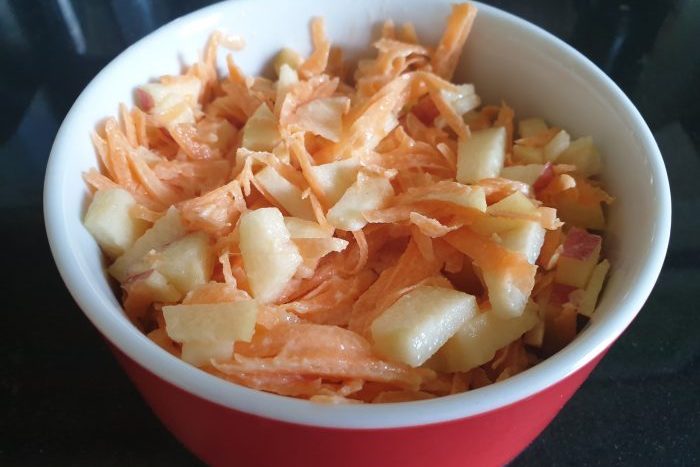Homemade coleslaw makes a tasty way of enjoying a variety of crunchy raw vegetables. This sweet and tasty take on coleslaw was suggested by one of our school support workers, Gill, who found that children loved the apple alternative to cabbage.
This recipe uses yogurt to give a lighter, healthier variation to fat-laden shop bought coleslaw. And just one 80 g serving provides one of your 5-a-day!
Skills Check
Follow a recipe; follow food safety & hygiene rules; use measuring spoons and cups; cut using the bridge/claw technique safely; use scissors safely; use a vegetable peeler safely; use a box grater safely; tidy away.
Equipment
Chopping board, vegetable peeler, sharp knife, box grater, measuring spoons, scissors, bowl, spoon.
Allergens (Please note the allergens listed are indicative only. Allergens vary depending on brand; check the labels on the products you use)
Mustard | Eggs | Milk | Sulphites
Ingredients (serves 2 children):
- 1 medium carrot, grated
- 1 spring onion, sliced/snipped
- 1/2 medium apple, skin on, sliced & chopped
- 1 teaspoon low fat natural/plain yogurt
- 1 teaspoon mayonnaise, light/reduced calorie
- 1/4 teaspoon Dijon mustard
Method
- Mix the yogurt, mustard and mayonnaise together in a bowl.
- Prepare and chop the apple and spring onions.
- Peel and grate the carrot.
- Tip all of the vegetables into the bowl and stir through the dressing.
N.B. You can store coleslaw in the fridge in a covered container for up to 3 days.
So thinking about Carrot & Apple Coleslaw ...

Yogurt is an excellent source of calcium, and a good source of Vitamin D for strong teeth and bones. It is also a good source of protein.
Nutritional Information
| Energy | 201kJ/48kcal | 2% | |
| Low | Fat | 1.3g | 2% |
| Low | Saturates | 0.2g | 1% |
| Med | Sugars | 6.2g | 7% |
| Low | Salt | 0.2g | 3% |
per 80g serving
% of an adult's reference intake
Typical values per 100g: Energy 254kJ / 61kcal
Notes
A traffic light system is used on nutrition labels to make it easier to see which foods and drinks are lower in calories, fat, sugar and salt. Try and choose more ‘greens’ and ‘ambers’ and fewer ‘reds’, and stick to smaller portions of ‘reds’.
Just because a recipe or a food has a red traffic light doesn’t mean you shouldn’t eat it. Understanding why a food or recipe might have a red light can be helpful. For example oily fish is high in total fat and so any recipe containing oily fish is likely to be ‘red’ for fat. But it is recommended that we eat oily fish at least once a week because the type of fat it contains is beneficial for our health.
% Reference Intakes are also shown. Reference Intakes are guidelines about the approximate amount of particular nutrients and energy required for a healthy diet (based on an average-sized woman doing an average amount of physical activity). Most children will require less than these Reference Intakes. The contribution of one serving of a food or drink to the Reference Intake for each nutrient is expressed as a percentage.




